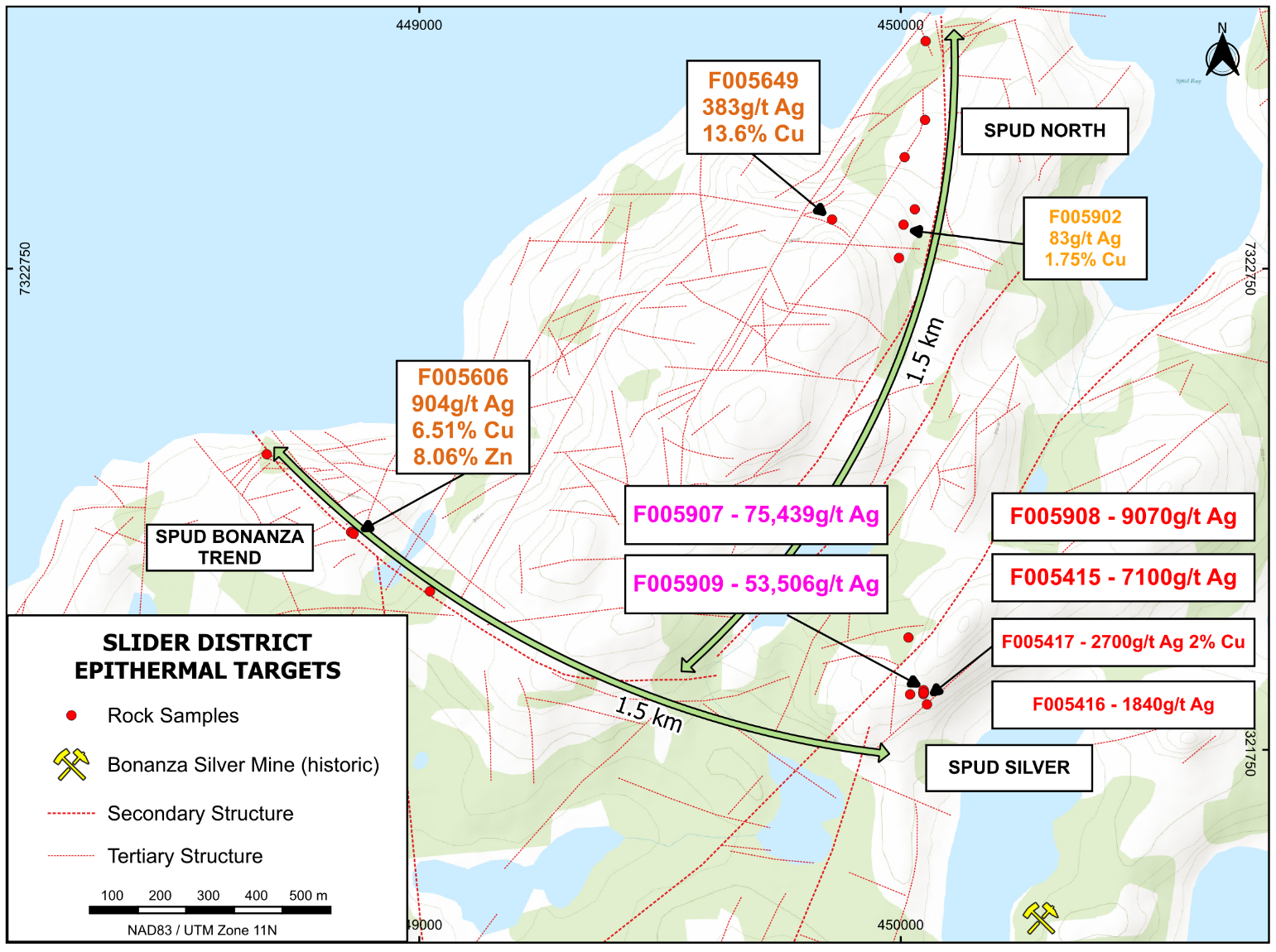Bonanza Grade Silver ±550mtrs from historic silver mines that produced 34,200,000oz of refined silver
Assays include 7.54% Ag (75,439g/t), 5.35% Ag (53,506g/t) & 13.6% Cu
Slider, a significantly expanded silver region a newly defined area of interest of at least 1.5km x 1.5km:
- includes a newly identified westerly extension of the two historical silver mines which includes a zone of native silver bearing breccias
- Results from Slider include bonanza silver concentrations shown below as percentage of silver, grammes of silver and ounces of silver:
| 7.54% Ag | (75,439g/t Ag or 2,425 Oz/t Ag) | (F005907) |
| 0.91% Ag | (9,070g/t Ag or 291 Oz/t Ag) | (F005908) |
| 5.35% Ag | (53,506g/t Ag or 1,720 Oz/t Ag) | (F005909) |
| 0.71% Ag | (7,100g/t Ag or 228 Oz/t Ag) | (F005414) |
| 0.18% Ag | (1,840g/t Ag or 59 Oz/t Ag) | (F005416) |
| 0.27% Ag | (2,700g/t Ag or 87 Oz/t Ag) | (F005417) |
- Additional newly identified E-W structural trend within the Slider region identified over ±450m of strike length returned assays up to 904g/t Ag, 6.5% Cu and 8.1% Zn (F005606)
- a similar mineralised structure, sampled over 450 m N-S also returned 383g/t Ag and 13.6% Cu (F005649)
Slider
The Silder District
The Slider District located 10km SW of the Phoenix regional scale IOCG-epithermal centres consists of 3 sub areas, Spud Silver, Spud Bonanza (E/W) and Spud North (N/S), all three of which have been proven to host high grade epithermal precious metal mineralisation. Slider is located around 550m NW of the historic Bonanza and El Bonanza silver mines which historically produced 23,564,461oz of silver between 1964-1976 (Figure 1). The field program, designed to test extensional structures along strike from these historic mines, has uncovered st6ructural extensions to the mine zone rich in silver and copper. Much of the central part of the 1.5 x 1.5km structural zone of Slider remains unexplored and unsampled even though it is highly prospective for significant metal accumulation.
A 4 m wide zone of native silver bearing hydrothermal breccia was located and sampled, returning bonanza silver grades up to 7.54% (F005907) and 5.35% (F005909). Sample F005907, which returned the highest silver grades, also hosts mineralisation disseminated within the pervasively chlorite altered host rock. The mineralisation is associated with pervasive and intense chlorite alteration with zones of semi-massive magnetite. Calcite and fluorite are observed within the mineralised breccias, with additional chalcopyrite-malachite returning 2700g/t Ag and 2% Cu (F005417). The mineral assemblage and style of mineralisation matches that of the nearby historic mines. A total of 9 samples were taken at the Spud Silver occurrence and surrounding areas.
Further targets within the Slider District exist along SE/NW and N/S trending structures. The Bonanza Trend, sampled over 440m is a zone of steeply NE dipping andesite flows and sediments with bedding parallel zones of mineralisation. Sample F005606 returned 904g/t Ag, 6.51% Cu and 8.06% Zn and sits immediately adjacent to a large, covered topographic depression which may host further mineralisation. A similar N/S trending structural zone sampled over 450m strike length also returned high-grade silver-copper mineralisation with 383g/t Ag and 13.6% Cu (F005649). 5 samples were taken along the NW/SE Bonanza trend and 7 samples along the N/S Spud North trend.

Photograph of sample F005909 which returned 5.35% Ag. Tarnished native silver and calcite cement can be observed between the clasts of potassic altered diorite.

Photograph of abundant native silver mineralisation in sample F005909 showing both tarnished and fresh silver within a calcite-chlorite matrix.

Photograph of sample F005907 which returned 7.54% Ag from the Spud Silver occurrence. Silver present within the chlorite altered host rock and within the breccia cement phase alongside calcite. Yellow arrows point to visible native silver.

Map of the Slider District 2024 rock samples which exhibit bonanza silver grades at Spud Silver. Much of the central area remains underexplored and will receive detailed follow up groundwork, with scope for further native silver discoveries.

Photograph of sample F005908, an intensely chlorite altered diorite with disseminated and vein hosted native silver which returned 9,070g/t Ag.
